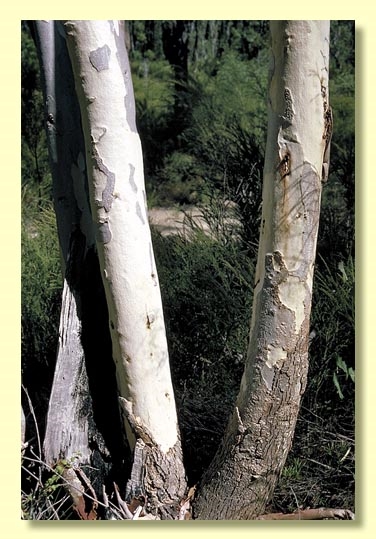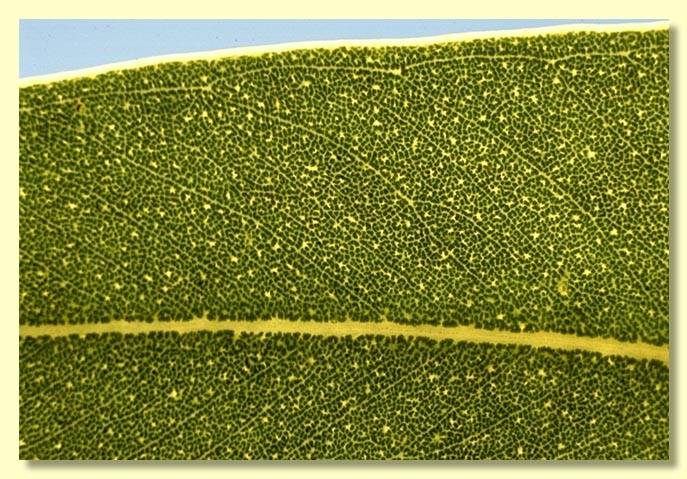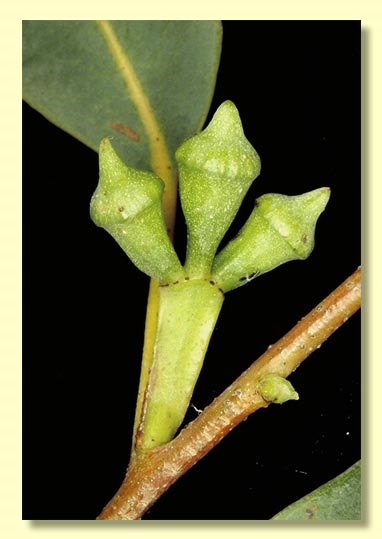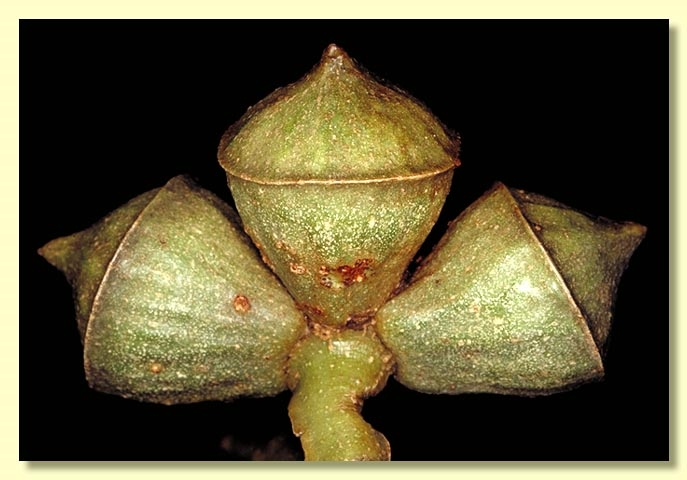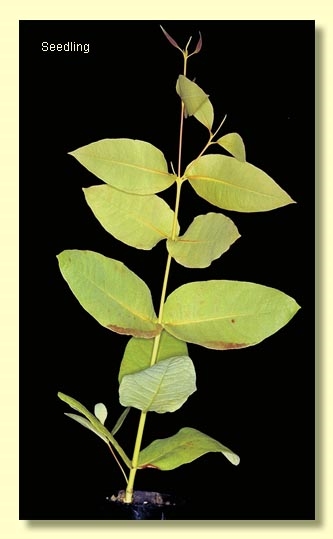Euclid - Online edition
Eucalyptus megacarpa
Eucalyptus | Eucalyptus | Longistylus | Frutices | Preissianae | Glandulares
T: Wilson Inlet, W.A., 1858, G.Maxwell; syn: MEL (2 specimens), PERTH (1 specimen).
Bark smooth, cream to cream-brown and bronze-grey.
Branchlets lacking oil glands in the pith.
Juvenile growth (coppice or field seedlings to 50 cm): stems square in cross-section; juvenile leaves opposite and sessile at lowest node then petiolate, alternate, broadly lanceolate, 10–13 cm long, 3.5–5 cm wide, tapering or oblique on petiole, dull, green, glabrous.
Adult leaves alternate, petioles 1.3–3.5 cm long; blade lanceolate to falcate, 7–14 cm long, 1.5–3.3 cm wide, base oblique or tapering to petiole, margin entire, apex a drip tip, concolorous, dull to slightly glossy, green, side-veins greater than 45° to midrib, reticulation dense to very dense, intramarginal vein close to margin, oil glands obscure or very irregular in shape.
Inflorescence axillary unbranched, peduncles flat, 1.2–2 cm long, buds 3, pedicels 0–0.4 cm long. Mature buds ovoid to obovoid or pyriform, 1.5–2.2 cm long, 1.2–1.7 cm wide, scar absent, the single operculum beaked, stamens inflexed, anthers oblong to cordate, versatile, dorsifixed, dehiscing by longitudinal non-confluent slits, style long and straight or bent, stigma tapered, locules 4 or 5, the placentae each with 2 vertical rows of ovules. Flowers white.
Fruit sessile or with pedicels to 0.2 cm, cupular to campanulate or hemispherical, 1.2–1.9 cm long, 1.8–3 cm wide, disc raised and lobed over the valves, valves 4 or 5.
Seeds black, 2–4.5 mm long, cuboid to D-shaped, dorsal surface minutely wrinkled, occasionally narrowly flanged, hilum terminal.
Cultivated seedlings (measured at ca node 10): cotyledons reniform, large; stems rounded to square in cross-section, scabrid at lower internodes, smooth after ca node 5 or 6; leaves sessile, amplexicaul and discolorous for ca 5 or 6 nodes then becoming petiolate, opposite to sub-opposite for at least 8–10 nodes, broadly ovate, 7.5–12.5(18.5) cm long, 3.5–9 cm wide, dull, mid-green. Margins of lower leaves minutely denticulate.
Flowering has been recorded in April, June and August.
A robust mallee or small to medium-sized tree endemic to Western Australia. It occurs from south and south-east of Perth to near Albany. The bark is smooth and the adult leaves dull to slightly glossy, green.
In the classification of Brooker (2000) Eucalyptus megacarpa belongs in Eucalyptus subgenus Eucalyptus series Preissianae, a small group characterised by smooth bark, buds in threes, buds with a single operculum (hence no operculum scar), cuboid anthers that shed pollen by two separate slits, ovules arranged in two rows on the placenta, fruit that are large with the disc lobed over the valves, seed pyramidal to cuboid and seedlings with sessile, opposite leaves for at least 10 nodes.
Series Preissianae has 4 species viz. E. megacarpa, E. preissiana (with two subspecies), E. coronata and E. aquilina. E. megacarpa is easily separated from its near relatives by the combination of tree or robust mallee habit, virtually smooth buds that are often spotty and have a beaked operculum, white flowers and fruit to 3 cm diameter.


